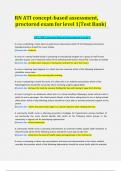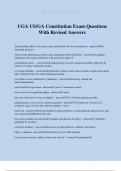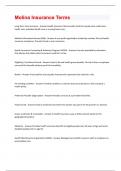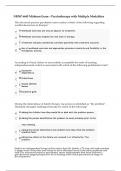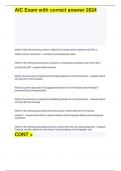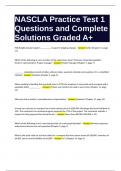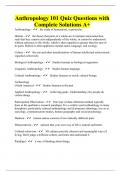CV
What is cardiac output?
o cardiac output is about 5 L/ minute.
o Hence, every minute, the heart pumps the equivalent of all the blood in the
body.
o CO = HR x SV
o an increase in HR or SV will increase CO,
o whereas a decrease in HR or SV will decrease CO.
Stroke volume?
o Stroke volume is determined largely by three factors:
(1) myocardial contractility,
(2) cardiac afterload, and
(3) cardiac preload.
o Myocardial contractility is defined as the force with which the ventricles
contract.
o Contractility is determined primarily by the degree of cardiac dilation, which in
turn is determined by the amount of venous return.
o In addition to regulation by venous return, contractility can be increased by
the sympathetic nervous system,
acting through beta1-adrenergic receptors in the myocardium.
Preload?
o Preload is formally defined as the amount of tension (stretch) applied to a
muscle before contraction.
o In the heart, stretch is determined by ventricular filling pressure, that is, the
force of venous return:
the greater filling pressure is, the more the ventricles will stretch.
o Cardiac preload can be expressed as either end-diastolic volume or end-
diastolic pressure.
o As discussed later, an increase in preload will increase SV,
o whereas a decrease in preload will reduce SV.
o Frequently, the terms preload and force of venous return are used
interchangeably— although they are not truly equivalent.
Afterload?
o Afterload is formally defined as the load against which a muscle exerts its
force (i.e., the load a muscle must overcome in order to contract).
o For the heart, afterload is the arterial pressure that the left ventricle must
overcome to eject blood.
o Common sense tells us that, if afterload increases, SV will decrease.
o Conversely, if afterload falls, SV will rise.
o Cardiac afterload is determined primarily by the degree of peripheral
resistance,
which in turn is determined by constriction and dilation of arterioles.
1
,Study Questions Module 5
That is, when arterioles constrict, peripheral resistance rises, causing
AP (afterload) to rise as well.
Conversely, when arterioles dilate, peripheral resistance falls, causing
AP to decline.
What is Starling’s Law? - venous return is the primary determinant of SV
o Starling's law states that the force of ventricular contraction is proportional to
muscle fiber length (up to a point).
o Accordingly, as fiber length (ventricular diameter) increases, there is a
corresponding increase in contractile force (Fig. 34.5).
o Because of this built-in mechanism, when more blood enters the heart, more
is pumped out.
o As a result, the healthy heart is able to precisely match its output with the
volume of blood delivered by veins.
o That is, when venous return increases, CO increases correspondingly.
o Conversely, when venous return declines, CO declines to precisely the same
extent.
o Hence, under normal, nonstressed conditions, SV is determined by factors
that regulate venous return.
What regulates artial pressure?
o Arterial pressure is the driving force that moves blood through the arterial side
of the systemic circulation.
o The general formula for AP is: AP = PR × CO
where AP is arterial pressure,
PR is peripheral resistance, and
CO is cardiac output.
o Accordingly, an increase in PR or CO will increase AP,
o whereas a decrease in PR or CO will decrease AP.
o Peripheral resistance is regulated primarily through constriction and dilation of
arterioles.
o Cardiac output is regulated by the mechanisms discussed previously.
AP is regulated primarily by three systems:
o the ANS,
o the renin-angiotensin-aldosterone system (RAAS),
o kidneys.
o These systems differ greatly with regard to timeframe of response.
o The ANS acts in two ways:
(1) it responds rapidly (in seconds or minutes) to acute changes in
blood pressure and
(2) it provides steady-state control.
o The RAAS responds more slowly, taking hours or days to influence AP.
o The kidneys are responsible for long-term control and hence may take days
or weeks to adjust AP.
2
, Study Questions Module 5
o Arterial pressure is also regulated by a fourth system: a family of natriuretic
peptides.
These peptides come into play primarily under conditions of volume
overload.
What are baroreceptors?
o The baroreceptor reflex serves to maintain AP at a predetermined level.
When AP changes, the reflex immediately attempts to restore AP to the preset
value.
o Baroreceptors (pressure sensors) in the aortic arch and carotid sinus sense
AP and relay this information to the vasoconstrictor center of the medulla.
o When AP changes, the vasoconstrictor center compensates by sending
appropriate instructions to arterioles, veins, and the heart.
o For example, when AP drops, the vasoconstrictor center causes
(1) constriction of nearly all arterioles, thereby increasing PR;
(2) constriction of veins, thereby increasing venous return; and
(3) acceleration of HR (by increasing sympathetic impulses to the heart
and decreasing parasympathetic impulses).
o The combined effect of these responses is to restore AP to the preset level.
o When AP rises too high, opposite responses occur: the reflex dilates
arterioles and veins and slows the heart.
What is the role of the natriuretic peptides?
o Natriuretic peptides serve to protect the cardiovascular system in the event of
volume overload,
a condition that increases preload, and thereby increases CO and AP.
o Volume overload is caused by excessive retention of sodium and water.
o Natriuretic peptides work primarily by
(1) reducing blood volume and
(2) promoting dilation of arterioles and veins.
o Both actions lower AP.
o The family of natriuretic peptides has three principal members:
atrial natriuretic peptide (ANP),
B- or brain natriuretic peptide (BNP), and
C-natriuretic peptide (CNP).
o ANP is produced by myocytes of the atria;
o BNP is produced by myocytes of the ventricles (and to a lesser extent by cells
in the brain, where BNP was discovered); and
o CNP is produced by cells of the vascular endothelium.
o When blood volume is excessive, all three peptides are released.
(Release of ANP and BNP is triggered by stretching of the atria and
ventricles, which occurs because of increased preload.)
ANP and BNP have similar actions.
Both peptides reduce blood volume and increase venous
capacitance and thereby reduce cardiac preload.
3


